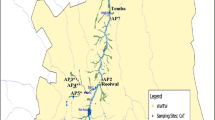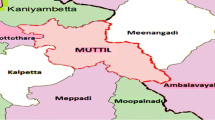Abstract
Purpose
Ballast water is one of the most important ways for the transfer of aquatic organisms such as Escherichia coli (E. coli) and Vibrio cholerae. The aim of this study was to investigate Mdh gene of E. coli and the OmpW gene of Vibrio cholerae bacteria by PCR technique in the ballast water of commercial ships entering Bushehr port along the Persian Gulf.
Methods
In this study, 34 samples of ballast water entered Bushehr port were studied by using culture and PCR methods to determine Mdh gene of E. coli and OmpW gene of Vibrio cholerae. Genomic DNA of bacterial strains was extracted and PCR was performed by using specific primers of E. coli and Vibrio cholerae.
Results
The specific Mdh gene of E. coli was detected in 4 ballast water samples and the positive samples were analyzed by antisera methods for E. coli O157:H7. Results of antisera showed that there were 3 positive samples of O157:H7 serotype. The results of the PCR technique showed that the OmpW gene of Vibrio cholerae was negative for all positive culture samples.
Conclusions
Further studies are highly recommended to monitor other aquatic organisms in ballast water to protect the marine environment.


Similar content being viewed by others
References
Schnurr RE, Walker TR. Marine transportation and energy use. In: Reference module in earth systems and environmental sciences. Elsevier: Amsterdam; 2019.
Cabrini M, Cerino F, de Olazabal A, Di Poi E, Fabbro C, Fornasaro D, et al. Potential transfer of aquatic organisms via ballast water with a particular focus on harmful and non-indigenous species: A survey from Adriatic ports. Mar Pollut Bull. 2019;147:16–35.
Dobaradaran S, Soleimani F, Nabipour I, Saeedi R, Mohammadi MJ. Heavy metal levels of ballast waters in commercial ships entering Bushehr port along the Persian Gulf. Mar Pollut Bull. 2018;126:74–6.
Singh B. Everything you wanted to know about ballast water exchange and management plan. J Mar Environ. 2016;18(4):964–82.
Kim Y, Aw TG, Teal TK, Rose JB. Metagenomic investigation of viral communities in ballast water. Environ Sci Technol. 2015;49(14):8396–407.
Soleimani F, Dobaradaran S, Taherkhani R, Saeedi R, Mohammadi MJ, Keshtkar M, et al. Assessment of microbial and physiochemical quality of ballast water in commercial ships entering Bushehr port, along the Persian Gulf. Desalin Water Treat. 2017;98:190–5.
Soleimani F, Dobaradaran S, Hayati A, Khorsand M, Keshtkar M. Data onmetals (Zn, Al, Sr, andCo) andmetalloid (As) concent rationlevels of ballastwaterincommercial ships entering Bushehr port, alongthe Persian Gulf. Data Brief. 2016;9:429–32.
Elçiçek H, Parlak A, Cakmakci M. Effect of ballast water on marine and coastal ecology. J Selcuk Univ Nat Appl Sci. 2013;1:454–63.
Gollasch S, Minchin D, David M. The transfer of harmful aquatic organisms and pathogens with ballast water and their impacts. Global maritime transport and ballast water management. Berlin: Springer; 2015. p. 35–58.
Lymperopoulou DS, Dobbs FC. Bacterial diversity in ships’ ballast water, ballast-water exchange, and implications for ship-mediated dispersal of microorganisms. Environ Sci Technol. 2017;51(4):1962–72.
Brinkmeyer R. Diversity of bacteria in ships ballast water as revealed by next generation DNA sequencing. Mar Pollut Bull. 2016;107(1):277–85.
Petersen NB, Madsen T, Glaring MA, Dobbs FC, Jørgensen NO. Ballast water treatment and bacteria: Analysis of bacterial activity and diversity after treatment of simulated ballast water by electrochlorination and UV exposure. Sci Total Environ. 2019;648:408–21.
Ng C, Le T-H, Goh SG, Liang L, Kim Y, Rose JB, et al. Correction: A comparison of microbial water quality and diversity for ballast and tropical harbor waters. PLoS One. 2016;11(4):e0154652.
Burkholder JM, Hallegraeff GM, Melia G, Cohen A, Bowers HA, Oldach DW, et al. Phytoplankton and bacterial assemblages in ballast water of US military ships as a function of port of origin, voyage time, and ocean exchange practices. Harmful Algae. 2007;6(4):486–518.
Altug G, Gurun S, Cardak M, Ciftci PS, Kalkan S. The occurrence of pathogenic bacteria in some ships’ ballast water incoming from various marine regions to the Sea of Marmara, Turkey. Mar Environ Res. 2012;81:35–42.
Pereira NN, Brinati HL. Onshore ballast water treatment: A viable option for major ports. Mar Pollut Bull. 2012;64(11):2296–304.
Dobroski N, Scianni C, Gehringer D, Falkner M. Assessment of the efficacy, availability and environmental impacts of ballast water treatment systems for use in California waters. Sacramento: California State Lands Commission Marine Facilities Division; 2009.
Branger C, Blanchard B, Fillonneau C, Suard I, Aviat F, Chevallier B, et al. Polymerase chain reaction assay specific for pathogenic Leptospira based on the gene hap1 encoding the hemolysis-associated protein-1. FEMS Microbiol Lett. 2005;243(2):437–45.
Xia X, Meng J, McDermott PF, Ayers S, Blickenstaff K, Tran T-T, et al. Presence and characterization of Shiga toxin-producing Escherichia coli and other potentially diarrheagenic E. coli strains in retail meats. Appl Environ Microbiol. 2010;76(6):1709–17.
Maheshwari M, Nelapati K, Kiranmayi B. Vibrio cholerae-a review. Vet World. 2011;4(9):423.
Lekshmi N, Joseph I, Ramamurthy T, Thomas S. Changing facades of Vibrio cholerae: An enigma in the epidemiology of cholera. Indian J Med Res. 2018;147(2):133.
Ottaviani D, Leoni F, Rocchegiani E, Santarelli S, Masini L, Di Trani V, et al. Prevalence and virulence properties of non-O1 non-O139 Vibrio cholerae strains from seafood and clinical samples collected in Italy. Int J Food Microbiol. 2009;132(1):47–53.
Lukinmaa S, Mattila K, Lehtinen V, Hakkinen M, Koskela M, Siitonen A. Territorial waters of the Baltic Sea as a source of infections caused by Vibrio cholerae non-O1, non-O139: report of 3 hospitalized cases. Diagn Microbiol Infect Dis. 2006;54(1):1–6.
Dutta D, Chowdhury G, Pazhani GP, Guin S, Dutta S, Ghosh S, et al. Vibrio cholerae non-O1, non-O139 serogroups and cholera-like diarrhea, Kolkata, India. Emerg Infect Dis. 2013;19(3):464.
De Keukeleire S, Hoste P, Crivits M, Hammami N, Piette A. Atypical manifestation of Vibrio cholerae: fear the water! Acta Clin Belg. 2018;73(6):462–4.
Fykse EM, Nilsen T, Nielsen AD, Tryland I, Delacroix S, Blatny JM. Real-time PCR and NASBA for rapid and sensitive detection of Vibrio cholerae in ballast water. Mar Pollut Bull. 2012;64(2):200–6.
Rivera IN, Souza KM, Souza CP, Lopes RM. Free-living and plankton-associated vibrios: assessment in ballast water, harbor areas, and coastal ecosystems in Brazil. Front Microbiol. 2012;3:443.
Eyisi OA, Nwodo UU, Iroegbu CU. Distribution of Vibrio species in shellfish and water samples collected from the Atlantic coastline of south-east Nigeria. J Health Popul Nutr. 2013;31(3):314.
Velazquez-Roman J, León-Sicairos N, Hernandez-Diaz LDJ, Canizalez-Roman A. Pandemic Vibrio parahaemolyticus O3: K6 on the American continent. Front Cell Infect Microbiol. 2014;3:110.
Epstein PR, Colwell RR, Ford TE. Marine ecosystems. Lancet. 1993;342(8881):1216–9.
McCarthy SA, Khambaty FM. International dissemination of epidemic Vibrio cholerae by cargo ship ballast and other nonpotable waters. Appl Environ Microbiol. 1994;60(7):2597–601.
Nandi B, Nandy RK, Mukhopadhyay S, Nair GB, Shimada T, Ghose AC. Rapid method for species-specific identification ofVibrio cholerae using primers targeted to the gene of outer membrane protein OmpW. J Clin Microbiol. 2000;38(11):4145–51.
Taherkhani R, Farshadpour F, Makvandi M, Hamidifard M, Esmailizadeh M, Ahmadi B, et al. Determination of cytomegalovirus prevalence and glycoprotein B genotypes among ulcerative colitis patients in Ahvaz, Iran. Jundishapur J Microbiol. 2015;8(2):e17458.
Abia ALK, Ubomba-Jaswa E, Momba MNB. Riverbed sediments as reservoirs of multiple vibrio cholerae virulence-associated genes: a potential trigger for cholera outbreaks in developing countries. J Environ Public Health. 2017;2017:5646480.
Tajbakhsh E, Khamesipour F, Ranjbar R, Ugwu IC. Prevalence of class 1 and 2 integrons in multi-drug resistant Escherichia coli isolated from aquaculture water in Chaharmahal Va Bakhtiari province, Iran. Ann Clin Microbiol Antimicrob. 2015;14(1):1–5.
Besser TE, Shaikh N, Holt NJ, Tarr PI, Konkel ME, Malik-Kale P, et al. Greater diversity of Shiga toxin-encoding bacteriophage insertion sites among Escherichia coli O157: H7 isolates from cattle than in those from humans. Appl Environ Microbiol. 2007;73(3):671–9.
Huq A, Haley BJ, Taviani E, Chen A, Hasan NA, Colwell RR. Detection, isolation, and identification of Vibrio cholerae from the environment. Curr Protoc Microbiol 2012;26(1):6A. 5.1-6A. 5.51.
Russo P, Botticella G, Capozzi V, Massa S, Spano G, Beneduce L. A fast, reliable, and sensitive method for detection and quantification of Listeria monocytogenes and Escherichia coli O157: H7 in ready-to-eatfresh-cut products by MPN-qPCR. BioMed Res Int. 2014;2014:608296.
Elizaquível P, Sánchez G, Aznar R. Quantitative detection of viable foodborne E. coli O157: H7, Listeria monocytogenes and Salmonella in fresh-cut vegetables combining propidium monoazide and real-time PCR. Food Control. 2012;25(2):704–8.
Kotzekidou P. Survey of Listeria monocytogenes, Salmonella spp. and Escherichia coli O157: H7 in raw ingredients and ready-to-eat products by commercial real-time PCR kits. Food Microbiol. 2013;35(2):86–91.
Maheshwari M, Krishnaiah N, Ramana D. Evaluation of polymerase chain reaction for the detection of vibrio cholerae in contaminants. Ann Biol Res. 2011;2(4):212–7.
Van Belkum A. DNA fingerprinting of medically important microorganisms by use of PCR. Clin Microbiol Rev. 1994;7(2):174–84.
Lv B, Cui Y, Tian W, Li J, Xie B, Yin F. Abundances and profiles of antibiotic resistance genes as well as co-occurrences with human bacterial pathogens in ship ballast tank sediments from a shipyard in Jiangsu Province, China. Ecotoxicol Environ Saf. 2018;157:169–75.
Aguirre-Macedo ML, Vidal-Martinez VM, Herrera-Silveira JA, Valdés-Lozano DS, Herrera-Rodríguez M, Olvera-Novoa MA. Ballast water as a vector of coral pathogens in the Gulf of Mexico: The case of the Cayo Arcas coral reef. Mar Pollut Bull. 2008;56(9):1570–7.
Pereira NN, Botter RC, Folena RD, Pereira JPFN, da Cunha AC. Ballast water: A threat to the Amazon Basin. Mar Pollut Bull. 2014;84(1–2):330–8.
Seiden JM, Way C, Rivkin RB. Microbial hitchhikers: dynamics of bacterial populations in ballast water during a trans-Pacific voyage of a bulk carrier. Aquat Invasions. 2010;5(1):13–22.
Steichen JL, Schulze A, Brinkmeyer R, Quigg A. All aboard! A biological survey of ballast water onboard vessels spanning the North Atlantic Ocean. Mar Pollut Bull. 2014;87(1–2):201–10.
Buzoleva L, Letyagina A, Zvyagincev A, Kashin I. Study of microorganisms coming into the port of Vladivostok with ballast water of ships. Rus J Biol Invasions. 2012;3(2):92–100.
Mary P, Chihib N, Charafeddine O, Defives C, Hornez J. Starvation survival and viable but nonculturable states in Aeromonas hydrophila. Microb Ecol. 2002;43:250–8.
Ryan ET, Hill DR, Solomon T, Endy TP, Aronson N. Hunter’s tropical medicine and emerging infectious diseases e-book. Amsterdam: Elsevier Health Sciences; 2019.
Secretariat I. Guidelines for approval of ballast water management systems (G8). London: International Maritime Organization; 2008.
Acknowledgements
The authors are grateful to the Bushehr University of Medical Sciences for their financial support (Grant no. 4101) and the laboratory staff of the Environmental Health Engineering Department for their cooperation.
Author information
Authors and Affiliations
Corresponding author
Ethics declarations
Conflict of interest
The authors declare that they have no known competing financial interests or personal relationships that could have appeared to influence the work reported in this paper.
Additional information
Publisher’s note
Springer Nature remains neutral with regard to jurisdictional claims in published maps and institutional affiliations.
Rights and permissions
About this article
Cite this article
Soleimani, F., Taherkhani, R., Dobaradaran, S. et al. Molecular detection of E. coli and Vibrio cholerae in ballast water of commercial ships: a primary study along the Persian Gulf. J Environ Health Sci Engineer 19, 457–463 (2021). https://doi.org/10.1007/s40201-021-00618-9
Received:
Revised:
Accepted:
Published:
Issue Date:
DOI: https://doi.org/10.1007/s40201-021-00618-9




